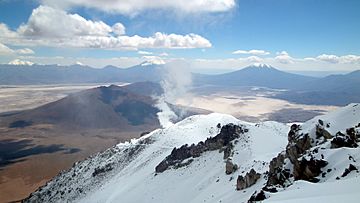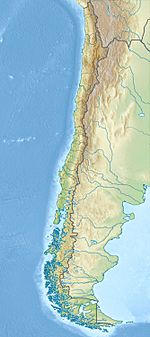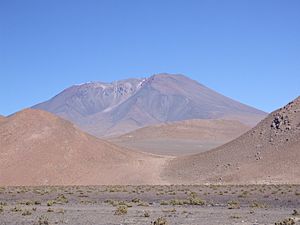Palpana facts for kids
Quick facts for kids Palpana |
|
|---|---|

The volcano is visible in the upper center portion of the photo, which was taken from the summit of Ollagüe volcano. Salar de Ascotán (left) and Salar de Carcote (right) are also visible in the photo.
|
|
| Highest point | |
| Prominence | 1,947 m (6,388 ft) |
| Parent peak | Aucanquilcha |
| Listing | Ultra |
| Geography | |
| Parent range | Andes |
| Climbing | |
| First ascent | 13 October 1977 - José Ambrus and Jaime Sepúlveda (Chile) |
Palpana (from pparpana, ram) is a volcano in the Andes of Chile. It has a summit elevation of 6,040 metres (19,820 ft).
It is part of the dividing range between Upper Loa River basin and Salar de Ascotán basin. Together with Inacaliri and Azufre, it forms a 50 kilometres (31 mi) long volcanic chain constructed along the Inacaliri lineament. The volcano rises above an ignimbrite plain that in the area reaches an altitude of 3,700 metres (12,100 ft) and forms a chain of volcanoes with Inacaliri.
A 1.3 by 1.8 kilometres (0.81 mi × 1.12 mi) wide crater surmounts the volcano and features late lava domes. A lava dome cluster is recognizable in the central sector of the volcano, forming a flat area with a surface of 4.7 square kilometres (1.8 sq mi). The volcano contains basaltic rocks with an extrusion formed from more silicic rock. Layers of mafic andesite, scoria and some pumice extend outwards away from the central sector. The volcano rises 6,023 metres (19,760 ft) above its terrain and its average summit slope is 26°. The western flank underwent a collapse, leaving a 2.9 kilometres (1.8 mi) wide and 5.9 kilometres (3.7 mi) long scar and a deposit at the volcano's foot. Olivine and plagioclase phenocrysts are found in the andesites, the overall SiO2 content is 57.6-58.9% in samples from the southern ridge. The volcano probably formed in a short timespan, given the mountainous composition and form.
The volcano is no more than 1-2 mya old, but there is no evidence of postglacial material and erosion has carved radial ridges into the volcano. Precise dating methods performed on the southeastern flank have found ages of 3.65±0.15 mya and 3.81±0.30 for lavas and scoria. The snowline altitude in the area is 5,900–6,000 metres (19,400–19,700 ft) Four moraine stages are found on the mountain, with the lowest moraines on the southern flank at 4,200 metres (13,800 ft) altitude. Nowadays, block glaciers have been identified in the area, one of which is found at 5,300 metres (17,400 ft). The mountain is also one of the headwaters of the Loa River, and water was transferred from Palpana to Antofagasta by pipeline. A minor vegetation cover of 20-25% of the surface is present.
The mountain is worshipped by pastoralist people who inhabit the surrounding land, and remnants of a sanctuary have been found on its summit.
See also
 In Spanish: Volcán Palpana para niños
In Spanish: Volcán Palpana para niños
- Cerro Chela
- Cerro de las Cuevas
- List of mountains in the Andes
- List of Ultras of South America



